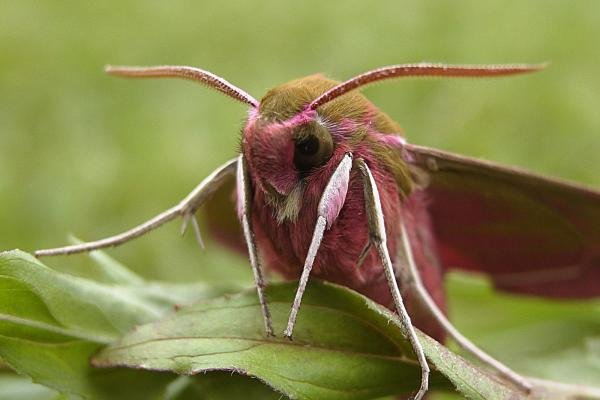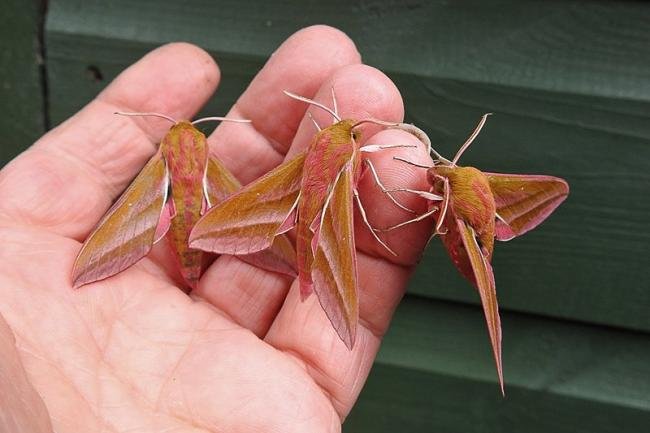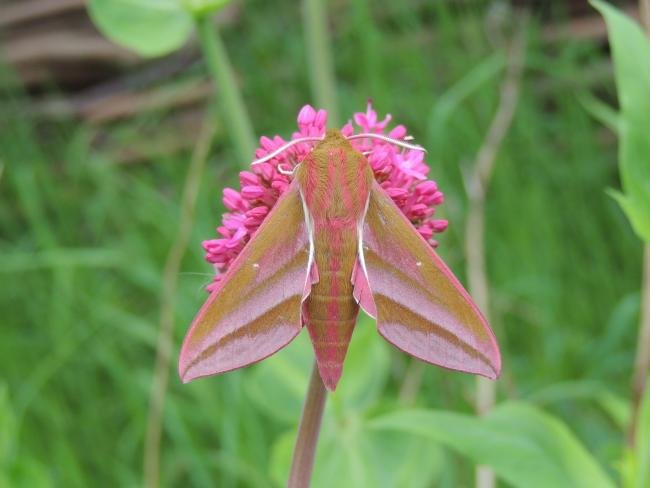Elephant Hawk-moth
Deilephila elpenor

Species account (old)
[...] The first notes of the species in any strength came in 1934 when J. B. Nicholson found an imago in July near Darlington, and a larva on a garden lawn a month later (Vasc. 20, 153): C. W. Murray had a moth in his greenhouse, also in Darlington, in the same year (Vasc. 21, 114). Then in 1935 J. E. Nowers reported large numbers of larvae (c. 20) in and around Darlington in August and September (Vasc. 21, 153). This was followed by a quite rapid spread throughout [...] spreading westwards to Hamsterley village [...] in 1943 [...] it was spreading over most of the lowland areas of Durham [...] It has never done so well in the west, however, although it has been seen in Teesdale at Eggleston (TCD) [...] but not in the Hamsterley Forest trap in recent times [...]. The rapid spread in the 1940's paralleled the extension of range of the Rose-bay Willowherb, the principal foodplant. Initially this became established along railway embankments where the normally wind-dispersed seed is believed to have been swept along on the slipstream of passing trains. The plant is a lover of dry slopes [...] especially where there has been disturbance of surface vegetation by public works or grass fires, creating open spaces for colonisation, and has now reached moorland verge habitats. The moth flies from mid-June to mid-July, and a second brood has been reared in captivity.
Statistics
| Records | 1085 |
|---|---|
| Individuals | 1611 |
| Largest Sample | 13 |
| First Recorded | 1934 |
| Last Recorded | 2024 |
| Earliest Adult Record | 07/05 |
| Latest Adult Record | 13/08 |
| Monad Coverage | 7.6% |
| Hexad Coverage | 83.3% |

Map
This map shows all records of Elephant Hawk-moth - Deilephila elpenor in the Durham (VC66) database per monad (1km grid square). The map can be explored further by zooming and panning, can be reset using the button on the left, and can be filtered by selecting the era. Click on a monad to view a full list of species recorded in it, or its containing hexad (10km grid square).

Week graph
This graph shows the County Durham (VC66) records of Elephant Hawk-moth - Deilephila elpenor per 7-day period, differentiated by life stage. Hover over/tap the graph to see an exact count of records at that point in time. Hover over/hold the life stage legend to highlight a particular life stage; click on a life stage label to remove it from the graph. The graph can be filtered further by selecting the era.
The graphs below show the total records and individuals of Elephant Hawk-moth - Deilephila elpenor in County Durham (VC66) per time period. Hover over/tap the graph to see an exact number of records and individuals at a particular point in time. Hover over/hold a label to highlight a particular metric; click on a metric label to remove it from the graph.
Era graph
Year graph

Gallery
This gallery shows images of Elephant Hawk-moth - Deilephila elpenor. Clicking on a photo opens it in a large lightbox with a full caption, and the arrow buttons move between photos. If you would like to contribute any photographs, particularly of any stages not captured here, please email admin@durhammoths.org. Most photos on this website have been taken by County Durham (VC66) recorders, but please note that not all have been taken in the county.

Foodplants
This is a list of foodplants known to be used by the larval stages of Elephant Hawk-moth - Deilephila elpenor in the UK.
Habitats
This is a list of habitats that Elephant Hawk-moth - Deilephila elpenor is known to occur in within the UK.
Habitat and foodplant information derived from Cook, P.M.; Tordoff, G.M.; Davis, A.M.; Parsons, M.S.; Dennis, E.B.; Fox, R.; Botham, M.S.; Bourn, N.A.D. (2022). Traits data for the butterflies and macro-moths of Great Britain and Ireland, 2022. NERC EDS Environmental Information Data Centre. https://doi.org/10.5285/33a66d6a-dd9b-4a19-9026-cf1ffb969cdb








